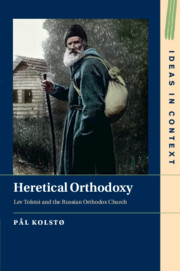Book contents
- Heretical Orthodoxy
- Ideas in Context
- Heretical Orthodoxy
- Copyright page
- Contents
- Preface
- Chapter 1 Introduction
- Chapter 2 Tolstoi as a Practicing Orthodox
- Chapter 3 Tolstoi’s Examination of Dogmatic Theology
- Chapter 4 Tolstoi, Orthodoxy and Asceticism
- Chapter 5 Lev Tolstoi and Orthodox Forms of Spirituality: Elders
- Chapter 6 Tolstoi and the Wanderer Tradition in Russian Culture
- Chapter 7 Tolstoi and the Ideal of “the Holy Fool”
- Chapter 8 Father Sergius: Kasatskii’s Spiritual Journey to Holy Foolishness
- Chapter 9 Tolstoi and the Social Ideal of the Eastern Church: John Chrysostom
- Chapter 10 The Church Mounts a Counterattack: Threat Perceptions and Combat Strategies
- Chapter 11 Between “Almost Orthodox” and “Antichrist”: Images of Lev Tolstoi in Russian Orthodox Polemics
- Chapter 12 The “Excommunication” and Its Aftermath
- Chapter 13 A Requiem for a Heretic? The Controversy over Lev Tolstoi’s Burial
- Chapter 14 Summary and Conclusions
- Bibliography
- Index
Chapter 4 - Tolstoi, Orthodoxy and Asceticism
Published online by Cambridge University Press: 15 September 2022
- Heretical Orthodoxy
- Ideas in Context
- Heretical Orthodoxy
- Copyright page
- Contents
- Preface
- Chapter 1 Introduction
- Chapter 2 Tolstoi as a Practicing Orthodox
- Chapter 3 Tolstoi’s Examination of Dogmatic Theology
- Chapter 4 Tolstoi, Orthodoxy and Asceticism
- Chapter 5 Lev Tolstoi and Orthodox Forms of Spirituality: Elders
- Chapter 6 Tolstoi and the Wanderer Tradition in Russian Culture
- Chapter 7 Tolstoi and the Ideal of “the Holy Fool”
- Chapter 8 Father Sergius: Kasatskii’s Spiritual Journey to Holy Foolishness
- Chapter 9 Tolstoi and the Social Ideal of the Eastern Church: John Chrysostom
- Chapter 10 The Church Mounts a Counterattack: Threat Perceptions and Combat Strategies
- Chapter 11 Between “Almost Orthodox” and “Antichrist”: Images of Lev Tolstoi in Russian Orthodox Polemics
- Chapter 12 The “Excommunication” and Its Aftermath
- Chapter 13 A Requiem for a Heretic? The Controversy over Lev Tolstoi’s Burial
- Chapter 14 Summary and Conclusions
- Bibliography
- Index
Summary
One important reason why Tolstoi so fiercely rejected Orthodox dogmatics was that he considered a purely theoretical approach to faith, disconnected from the lives of the believers, to be useless. Therefore, he had far greater sympathy with the Orthodox mystic-ascetic devotional literature associated with the so-called Hesychast movement. Chapter 4 analyzes Tolstoi’s exposure to this Orthodox monastic spirituality and how it influenced his thinking. He had a well-thumbed copy of Philokalia (Dobrotoliubie), a basic text of Orthodox spirituality and the most important of the Hesychast writings. Here, Tolstoi found confirmation of his strongly negative views of the body and the passions. The Philokalia taught that we should not merely control but indeed extinguish our passions. Passionlessness, apatheia – a concept also found among the Stoics and in Buddhism – should be the aim of the Christian life. This was an ideal that Tolstoi preached and which informed many of his views, on the necessity of physical labor, nonresistance to evil, and abstention from property, drugs, alcohol and even sex. Moreover, also Tolstoi’s claim that the essence of human life is not only spiritual but divine has a clear affinity with the Orthodox doctrine of theosis, the deification of man.
- Type
- Chapter
- Information
- Heretical OrthodoxyLev Tolstoi and the Russian Orthodox Church, pp. 71 - 88Publisher: Cambridge University PressPrint publication year: 2022



